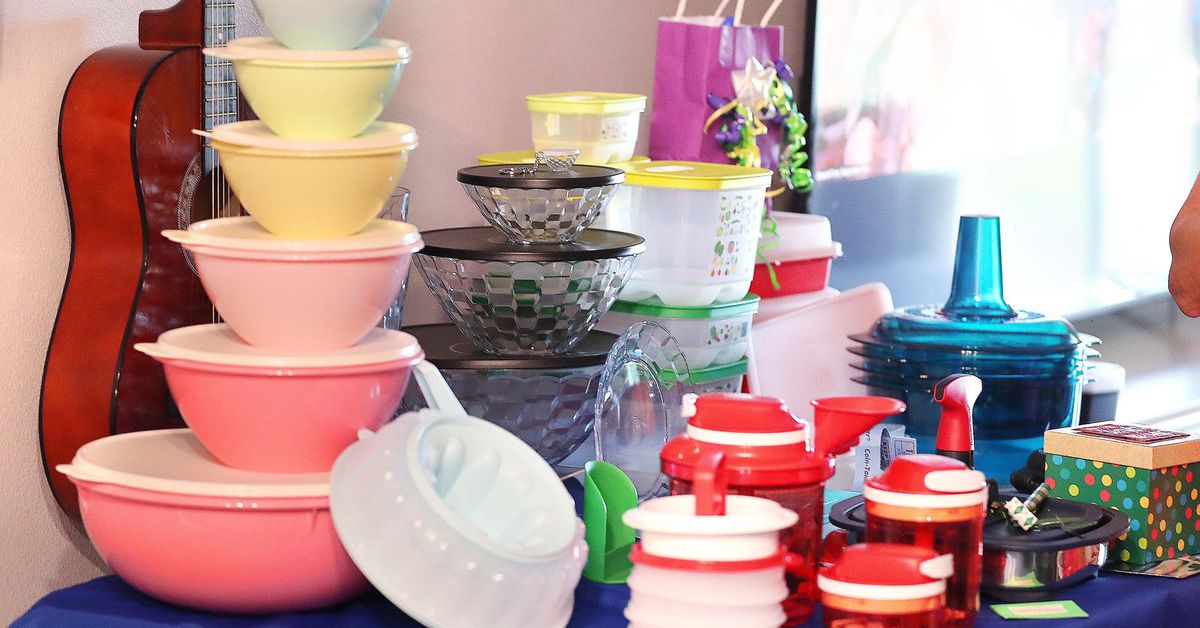This week, after more than 70 years of selling plastic storage containers of all shapes and sizes, Tupperware Brands announced Tupperware has announced its intention to file for bankruptcy. In a press release, the company cited “macroeconomic challenges” as the reason for the filing and is seeking court approval to continue operations during the process. More broadly, it promised to protect its “iconic brand and continue to drive Tupperware’s transformation into a digital and technology company.” But given the ubiquity of the Tupperware name (it’s now used to describe many food storage products that aren’t actually made by Tupperware), how did we end up here?
Founded in 1942 by Earl TupperTupperware was, at the time, a revolutionary business model. It offered women the opportunity to earn their own money through the “party model,” where an independent Tupperware representative would host a party, show off the company’s bowls and jars, and hope that her friends would like them enough to buy some at the end. We now know this model as “direct sales,” or, more pejoratively, “multilevel marketing”, and has been heavily criticized as an exploitative way of doing business, often leaving those who invest in the “opportunity” in serious debt. Most people who go into a multi-level marketing business will never make a profit, but that didn’t stop Tupperware from recruiting more than 3 million “independent consultants” —also known as sellers—around the world in 2020.
Anyone who grew up in the 80s or 90s probably remembers their mom attending (or hosting) a Tupperware party. Or maybe you remember seeing Those iconic storage bins from the 70swhich still fetch solid prices in antique malls and in eBayFor decades, Tupperware containers were a staple in American kitchens. I still remember my grandmother pouring sweet iced tea into a huge brown pitcher from that era, a genius innovation because the totally 80s color scheme hid the inevitable tannin stains from years of storing Luzianne.
However, in recent years, Tupperware has struggled to remain relevant. Collaborations with brands such as Vera Bradley and appearances in The Marvelous Mrs. Maisel Not much has changed. In 2022, finally sensing a decline in the popularity of Tupperware parties and online MLM sales, Tupperware launched its products at Targetits first distribution deal with a major retailer. That wasn’t enough: in 2023, The company announced that it would need a cash injection to stay afloat.And this week’s bankruptcy filing indicates that those financial problems have only gotten worse. Now, it is estimated that Tupperware has about a quarter of a million consultants. actively working to sell their products, according to NPR.
Without a doubt, a large part of Tupperware’s decline can be attributed to The general decline in popularity of direct selling companiesBut it’s also true that somewhere along the way, Tupperware seems to have gotten confused about what its customers really want in a kitchen product.
Tupperware has gotten very, very strange in recent years. The company has always sold random gadgets and single-task containers (my mother had a Tupperware container designed to hold exactly half an onion), but the company has, lately, decided to focus on microwave cooking. One of its most notable offerings is a Pressure cooker designed for use in the microwave.and by the way has produced some of the most repulsive cooking videos YouTube has ever seen. If you’ve ever wanted to know This is what it looks like when you microwave a whole chicken under pressure for 30 minutesNo, you don’t really.
The company also sells a multi-tier microwave steamerwhich states that It can cook your whole dinner at onceall in the microwave. “In the Stack Cooker Rice Cooker, meat stays moist, cakes bake up fluffy, and sauces and dressings come out creamier than ever,” the product description reads. “You won’t believe this microwave magic.” On the one hand, you have to commend Tupperware for trying to make the task of making dinner every night a little easier. On the other hand, you have to be a little horrified by the way the company thinks about cooking and why anyone would want to eat a cake cooked in a plastic container on top of microwaved chicken.
It’s clear that the idea of quality plastic storage containers was a success, which is why we colloquially call everything Tupperware, even the Flimsy plastic takeout containers I insist on keeping it, but almost everything else the company has released in the last few years is not something anyone really needs. Sure, we all want dinner to be easier, but we also want it to taste good. In this age of slow cookers and instant pots and rice cookers and every other gadget under the sun, why would anyone resort to steaming their entire dinner in the microwave?
In the end, Tupperware was left behind. And while there’s no denying the place Tupperware has had in American kitchens for the past 70 years, it doesn’t look like it’ll have that same place in our future.
Disclaimer:
The information contained in this post is for general information purposes only. We make no representations or warranties of any kind, express or implied, about the completeness, accuracy, reliability, suitability or availability with respect to the website or the information, products, services, or related graphics contained on the post for any purpose.
We respect the intellectual property rights of content creators. If you are the owner of any material featured on our website and have concerns about its use, please contact us. We are committed to addressing any copyright issues promptly and will remove any material within 2 days of receiving a request from the rightful owner.

